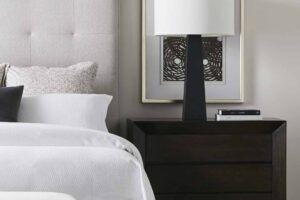
In the age of environmental awareness and sustainable living, designers are becoming increasingly selective about the materials and products they use to create beautiful, functional interiors. Among the most critical decisions for conscious designers is the choice of furniture. Eco-friendly furniture doesn’t just support the planet; it also complements curated interiors with style, elegance, and longevity. More than ever, sustainable design is being redefined through innovation, craftsmanship, and luxury, harmonizing aesthetics with values. Whether outfitting a residential oasis or a hospitality venue, designers now have access to a wealth of sustainable options that rival traditional pieces in appeal and performance.
Redefining Luxury: The Rise of Sustainable High-End Furniture
For decades, luxury furniture was synonymous with rarity, opulence, and sometimes extravagance, often overlooking environmental cost. However, the new wave of high-end home décor is reshaping what luxury means. Today, designer finishing touches are no longer defined solely by visual appeal or price tag, but by the thoughtfulness of the materials used, the transparency of the supply chain, and the ethical treatment of workers.
Many contemporary furniture designers now work with reclaimed wood, recycled metals, and plant-based resins to craft pieces that are as striking as they are sustainable. Bamboo, for instance, is a fast-growing renewable resource that’s used to manufacture everything from chairs to bed frames. Brands are also incorporating organic textiles, such as hemp and linen, into their upholstery to reduce environmental impact.
This shift isn’t just aesthetic—it’s part of a broader cultural evolution. The appeal of eco-friendly furniture lies not only in its low ecological footprint but also in its story. Clients investing in high-end home décor want to know where their pieces come from, how they’re made, and how they contribute to a healthier planet. This desire for meaningful design is helping elevate sustainability from a trend to a cornerstone of luxury interiors.
Materials Matter: Choosing Wisely for a Smaller Footprint
At the heart of sustainable furniture design is material selection. While traditional furniture can be made with composite woods filled with formaldehyde or synthetic fibers with petroleum-based dyes, eco-conscious designers look for greener alternatives.
Wood is still a popular material, but sustainably harvested options certified by the Forest Stewardship Council (FSC) are prioritized. These woods come from responsibly managed forests and are often treated with low-VOC finishes to minimize indoor air pollution. Reclaimed wood, salvaged from old barns or factories, provides a second life for lumber and carries a unique historical character that adds richness to curated interiors.
Another eco-forward choice is recycled metal. Aluminum and steel, for example, can be melted down and repurposed without losing strength or quality, making them ideal for modern, industrial-style furniture. These metals can be incorporated into sleek coffee tables, bold shelving units, and artistic accent chairs, all while minimizing raw material extraction.
For soft furnishings, natural textiles like organic cotton, wool, and jute are gaining favor. They offer breathability and tactile comfort without the toxic load of synthetic alternatives. Even cushions and mattresses are being redesigned with biodegradable or recycled fills, ensuring that luxury home accessories remain planet-friendly.
The Power of Local and Handcrafted Design
Supporting local artisans and manufacturers is another impactful way designers can practice sustainability. Locally made furniture reduces the carbon emissions associated with transportation and fosters regional economies. More importantly, it strengthens the connection between the designer, the maker, and the final product, allowing for greater customization and storytelling.
Handcrafted furniture also embodies a slower, more intentional mode of production. These pieces are built with longevity in mind, often using time-honored techniques that surpass the mass-produced alternatives in quality and durability. From mortise-and-tenon joinery to hand-carved embellishments, craftsmanship elevates the aesthetic of a piece while reinforcing its eco-value.
Incorporating these items into curated interiors can also enhance their exclusivity and character. Unlike mass-market offerings, handcrafted furniture celebrates uniqueness—each piece becomes a signature element of the space. The blend of sustainability, artisan tradition, and customization forms a trio that defines modern luxury for conscious designers.
Enhancing Ambience with Eco-Friendly Decorative Lighting
Lighting plays a pivotal role in setting the tone of a space, and fortunately, there’s an abundance of sustainable decorative lighting options that align with environmentally responsible design. From chandeliers made of recycled glass to pendant lamps crafted with natural fibers like rattan or seagrass, lighting can be both a focal point and a statement of intent.
LED technology has revolutionized the eco-lighting landscape. LEDs use a fraction of the energy of traditional incandescent bulbs and last significantly longer, reducing waste. Designers can now source LED-integrated fixtures that are compatible with smart home systems, allowing users to optimize lighting efficiency throughout the day.
In terms of design, decorative lighting fixtures often act as sculptural elements within high-end home décor. Artisans are pushing the boundaries by incorporating unexpected sustainable materials like cork, bamboo veneer, and even 3D-printed biodegradable plastics into their designs. These innovative touches offer designer finishing touches that blend environmental mindfulness with avant-garde aesthetics.
Additionally, sourcing lighting from companies with ethical labor practices and carbon-neutral operations further reinforces the holistic nature of sustainable interiors. These details, while subtle, underscore the authenticity and integrity of a designer’s vision.
The Future of Eco-Conscious Design: A Harmonious Blend of Style and Responsibility
As sustainability becomes increasingly mainstream, conscious designers are finding themselves at the forefront of a creative and cultural shift. Eco-friendly furniture is no longer a compromise—it’s a catalyst for innovation. It challenges designers to think beyond the visual, to consider lifecycle, provenance, and impact.
The fusion of sustainability with high-end home décor offers a compelling narrative: beauty and responsibility can coexist. Luxury home accessories and designer finishing touches that prioritize the planet do more than furnish a room—they inspire and educate. They show clients that living well doesn’t have to come at the cost of the environment.
Furthermore, sustainable design aligns with the growing demand for wellness-centered living. Eco-friendly furniture contributes to healthier indoor environments by minimizing off-gassing and promoting the use of natural materials. This makes them particularly attractive in residential projects, boutique hospitality, and wellness retreats, where the quality of the space directly affects wellbeing.
Conclusion
Making sustainable choices in furniture isn’t just a nod to environmental trends—it’s a design philosophy that elevates every element of an interior. From materials and craftsmanship to lighting and accessories, eco-conscious decisions enrich curated interiors with meaning and longevity. For designers looking to marry aesthetic excellence with ethical integrity, eco-friendly furniture is not just an option—it’s the future.




